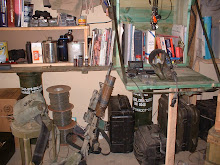I enjoy your blog, and check it out daily. How did you come to join the US military?

So, a Melbourne boy, huh? And a 'Pies supporter too. Definitely authentic, as nobody would make that up.

Blood is thicker than water.
I too am from Melbourne, variously Box Hill, Mount Martha and South Yarra. But happily in Perth these last 20 years. Yet still a Hawthorn supporter these past 40-odd years.

Anyway, my question is this: Why does the US military designate a 2LT with gold bars, but a 1LT with silver?

Second Lieutenant, United States

First Lieutenant, United States
Likewise, a major with the gold device, but a Lt Col with silver? You'd expect the reverse, eh?
Just curious.
Regards,
Greg
*********************************************************************
Hello Greg,
Good to hear from a fellow Melbournian. Tell me was I exaggerating about the penguins? I swear I saw them swimming in the bay that one time.
 The Natives are Friendly
The Natives are FriendlyI joined the US Army because I wanted to be a soldier, ever since I was a kid. I considered joining the Australian Army, but at the time they weren't going anywhere except the outback; I love Australia, but I wanted to see the world. I SERIOUSLY thought about joining the French Foreign Legion - all I had to do was make it to Tahiti, but the US military seemed like such a better deal.
 Sean Linnane, STORMBRINGER
Sean Linnane, STORMBRINGERIt turned out to be a good plan - I saw the world, I have enough adventures to fill ten lifetimes, and I retired from active duty into the most incredible professional network in the world.
As far as the bars and the oak leaves go - here's what I learned:
The present system of US officers’ grade insignia began on 18 June 1780 when it was prescribed that Major Generals would wear two stars and Brigadier Generals one star on each epaulette. In 1832, the Colonel’s eagle was initiated and in 1836, leaves were adopted for Lieutenant Colonels and Majors, while Captains received two bars and one bar was prescribed for First Lieutenant. Second Lieutenants did not receive the gold bar until December 1917.

Major, United States
In General Regulations of 1835, the leaf was first introduced to designate Lieutenant Colonels and Majors. It stated that it was embroidered on the shoulder straps of the frock coat, one at each end, each leaf extending 7/8 of an inch from the end of the border of the strap. The color for Lieutenant Colonels was to be the same color as the border. At this time, Infantry Lieutenant Colonels had a silver border and other Lieutenant Colonels had a gold border. For Majors, it was stipulated that the insignia would be the same design as the Lieutenant Colonel except the leaves would be silver where the border was gold and the insignia would be gold if the border was silver. This policy resulted in the use of both gold and silver leaves for both ranks.

Lieutenant Colonel, United States
In 1851, the border of all shoulder straps was changed to gold. As a result, the leaf for Lieutenant Colonel became silver and for Major it was gold for wear on the shoulder straps.
I don't know about the reasoning behind the silver insignia for First Lieutenants, and gold for Second Lieutenants.
You'd expect the reverse - what can I say? That's officers for you.
Thanks for reading STORMBRINGER, and thank you for your support.
- Sean L.
*********************************************************************
Onya Sean! And you're right, that's officers for you.
Happy landings,
Greg




















































